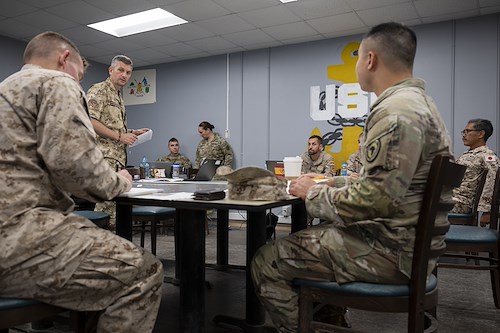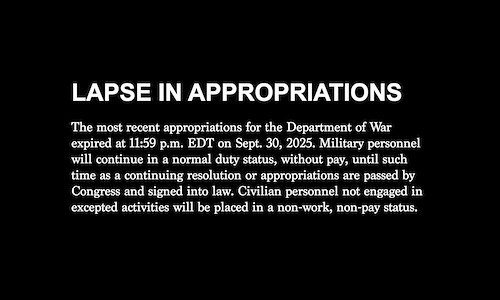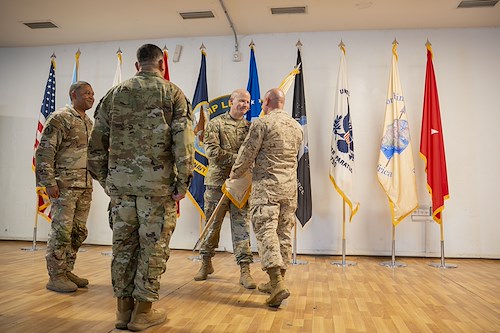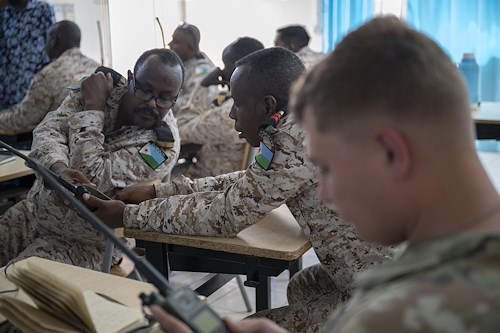Gallery contains 12 images
×
Photo 1 of 12
Combined Joint Task Force - Horn
Combined Joint Task Force - Horn of Africa U.S. service members and partners from France, Italy, Japan, Spain and South Korea participate in a Multinational Coordination Cell tabletop exercise at Camp Lemonnier, Djibouti, June 24, 2025. The MNCC tabletop exercise tested participant crisis response capabilities to maintain readiness and increase interoperability in a crisis situation. (U.S. Air Force photo by Marcus Hardy-Bannerman)
Photo by: Staff Sgt. Marcus Hardy-Bannerma
Photo 2 of 12
Combined Joint Task Force - Horn
Spanish Air and Space Force Lt. Ricardo Coello, left, Air Tactical Detachment Orion public affairs officer, and Maj. Fernando Pelegrina, Air Tactical Detachment Orion foreign liaison officer, work together during a Combined Joint Task Force - Horn of Africa Multinational Coordination Cell tabletop exercise at Camp Lemonnier, Djibouti, June 24, 2025. The interoperability built over the three-day exercise increased collaboration and coordination between CJTF-HOA personnel and partner forces, ensuring U.S., ally, and partner personnel are prepared to respond in a crisis situation. (U.S. Air Force photo by Marcus Hardy-Bannerman)
Photo by: Staff Sgt. Marcus Hardy-Bannerma
Photo 3 of 12
Combined Joint Task Force - Horn
U.S. Marine Corps Capt. Scott Whitley, Combined Joint Task Force - Horn of Africa Multinational Coordination Cell deputy, participates in an MNCC tabletop exercise at Camp Lemonnier, Djibouti, June 24, 2025. The exercise tested participants’ crisis response capabilities to maintain readiness and increase interoperability in a crisis situation. (U.S. Air Force photo by Marcus Hardy-Bannerman)
Photo by: Staff Sgt. Marcus Hardy-Bannerma
Photo 4 of 12
Combined Joint Task Force - Horn
U.S. Army Brig. Gen. Andrew Ballenger, Combined Joint Task Force - Horn of Africa deputy commanding general, greets partner nation foreign liaison officers during a Multinational Coordination Cell tabletop exercise at Camp Lemonnier, Djibouti, June 25, 2025. The MNCC tabletop exercise tested participant crisis response capabilities to maintain readiness and increase interoperability in a crisis situation. (U.S. Air Force photo by Marcus Hardy-Bannerman) (This photo has been altered for security purposes by blurring out identification badges.)
Photo by: Staff Sgt. Marcus Hardy-Bannerma
Photo 5 of 12
Combined Joint Task Force - Horn
Spanish Air and Space Force Maj. Fernando Pelegrina, left, Air Tactical Detachment Orion foreign liaison officer, collaborates with other Combined Joint Task Force - Horn of Africa
foreign liaison officers during a Multinational Coordination Cell tabletop exercise at Camp Lemonnier, Djibouti, June 24, 2025. The CJTF-HOA MNCC is a collaborative group of U.S. and partner force representatives, designed to coordinate crisis response operations in the case of an event affecting the U.S. and partner nation personnel within the U.S. Africa Command area of responsibility. (U.S. Air Force photo by Marcus Hardy-Bannerman)
Photo by: Staff Sgt. Marcus Hardy-Bannerma
Photo 6 of 12
Combined Joint Task Force - Horn
U.S. Army Sgt. Henry Warwick, Combined Joint Task Force - Horn of Africa foreign liaison officer coordinator, participates in a Multinational Coordination Cell tabletop exercise at Camp Lemonnier, Djibouti, June 24, 2025. The CJTF-HOA MNCC is a collaborative group of U.S. and partner force representatives, designed to coordinate crisis response operations in the case of an event affecting the U.S. and partner nation personnel within the U.S. Africa Command area of responsibility. (U.S. Air Force photo by Marcus Hardy-Bannerman)
Photo by: Staff Sgt. Marcus Hardy-Bannerma
Photo 7 of 12
Combined Joint Task Force - Horn
Foreign liaison officers with the Combined Joint Task Force - Horn of Africa discuss events during a Multinational Coordination Cell tabletop exercise at Camp Lemonnier, Djibouti, June 24, 2025. The MNCC tabletop exercise tested participants’ crisis response capabilities to maintain readiness and increase interoperability in a crisis situation. (U.S. Air Force photo by Marcus Hardy-Bannerman)
Photo by: Staff Sgt. Marcus Hardy-Bannerma
Photo 8 of 12
Combined Joint Task Force - Horn
Combined Joint Task Force - Horn of Africa U.S. service members and partners from France, Italy, Japan, Spain and South Korea participate in a Multinational Coordination Cell tabletop exercise at Camp Lemonnier, Djibouti, June 26, 2025. The interoperability built over the three-day exercise increased collaboration and coordination between CJTF-HOA personnel and partner forces, ensuring U.S., ally, and partner personnel are prepared to respond in a crisis situation. (U.S. Air Force photo by Marcus Hardy-Bannerman) (This photo has been altered for security purposes by blurring out identification badges.)
Photo by: Staff Sgt. Marcus Hardy-Bannerma
Photo 9 of 12
Combined Joint Task Force - Horn
An Italian foreign liaison officer with Combined Joint Task Force - Horn of Africa talks on the phone during a Multinational Coordination Cell tabletop exercise at Camp Lemonnier, Djibouti, June 24, 2025. The interoperability built over the three-day exercise increased collaboration and coordination between CJTF-HOA personnel and partner forces, ensuring U.S., ally, and partner personnel are prepared to respond in a crisis situation. (U.S. Air Force photo by Marcus Hardy-Bannerman)
Photo by: Staff Sgt. Marcus Hardy-Bannerma
Photo 10 of 12
Combined Joint Task Force - Horn
U.S. Army Maj. Ryan Lindberg, Combined Joint Task Force - Horn of Africa Multinational Coordination Cell officer in charge, participates in an MNCC tabletop exercise at Camp Lemonnier, Djibouti, June 25, 2025. The interoperability built over the three-day exercise increased collaboration and coordination between CJTF-HOA personnel and partner forces, ensuring U.S., ally, and partner personnel are prepared to respond in a crisis situation. (U.S. Air Force photo by Marcus Hardy-Bannerman)
Photo by: Staff Sgt. Marcus Hardy-Bannerma
Photo 11 of 12
Combined Joint Task Force - Horn
Spanish Air and Space Force Lt. Ricardo Coello, right, Air Tactical Detachment Orion public affairs officer, works together with Combined Joint Task Force - Horn of Africa U.S. service members and foreign liaison officers during a Multinational Coordination Cell tabletop exercise at Camp Lemonnier, Djibouti, June 24, 2025. The CJTF-HOA MNCC is a collaborative group of U.S. and partner force representatives designed to coordinate crisis response operations in the case of an event affecting the U.S. and partner nation personnel within the U.S. Africa Command area of responsibility. (U.S. Air Force photo by Staff Sgt. Marcus Hardy-Bannerman)
Photo by: Staff Sgt. Marcus Hardy-Bannerma
Photo 12 of 12
Combined Joint Task Force - Horn
U.S. Army Lt. Col. Kevin Merrill, Combined Joint Task Force - Horn of Africa Strategy and Plans deputy director, briefs Brig. Gen. Andrew Ballenger, CJTF-HOA deputy commanding general, on a Multinational Coordination Cell tabletop exercise at Camp Lemonnier, Djibouti, June 25, 2025. The MNCC tabletop exercise tested participants’ crisis response capabilities to maintain readiness and increase interoperability in a crisis situation. (U.S. Air Force photo by Marcus Hardy-Bannerman) (This photo has been altered for security purposes by blurring out identification badges.)
Photo by: Staff Sgt. Marcus Hardy-Bannerma
The Combined Joint Task Force - Horn of Africa Multinational Coordination Cell hosted a tabletop exercise with French, Italian, Japanese, Spanish and South Korean partners June 23-26 at Camp Lemonnier, Djibouti.
The three-day exercise simulated a crisis response situation, requiring those involved to work together, coordinating the movement of noncombatant personnel from a hostile location. The intent was for participants to do this through collaborative methods, increasing interoperability between partner forces.
The CJTF-HOA MNCC is a collaborative group of U.S. and partner force representatives designed to coordinate crisis response operations in the case of an event affecting the U.S. and partner nation personnel within the U.S. Africa Command area of responsibility.
“In Eastern Africa, if there is a crisis where our allies and partners are responding, the MNCC is sort of the fusion center for all of our operations,” said U.S. Army Maj. Ryan Lindberg, CJTF-HOA MNCC officer in charge.
Lindberg also said these exercises are essential, because it involves everyone’s input to portray an accurate representation of land, sea, and air operations.
Exercising crisis scenarios maintains readiness in the case of a real-world event, allowing U.S. and partner forces to confront and manage potential limiting factors and issues in a low-stress, controlled environment.
Lindberg was thankful these types of crises are not common, but expressed this fact made it even more important to exercise the scenario, as the potential is always there, ensuring there is a plan for “what we do, how we communicate, and how we work together with our allies and partners to make sure we can get all of our people out,” should the time come.
The scenario for this exercise was the simulated evacuation of noncombatants from U.S. and partner nation embassies in a designated country, with participants coordinating the movement of thousands of personnel to a safe location.
“From an operational standpoint, for the Italian Military Support Base, this exercise serves as a valuable rehearsal, particularly in terms of communication and interaction within the MNCC staff,” said Italian Navy Cdr. Patrizio Perin, Italian foreign liaison officer to CJTF-HOA. “More importantly, it consolidates the progress achieved in the field of security and regional stabilization, stemming from the effectiveness and ongoing training support provided through cooperation with the international community.”
Previous iterations of this exercise have offered insights that the MNCC has used to refine and improve the exercise. This version of the exercise was optimized to more adequately address possible real-world limitations, while also mimicking a setup similar to a real crisis.
Lindberg noted some changes for this iteration of the exercise, such as the integration of advanced communication systems intended to give a common operating picture, the addition of a crisis air planner to assist with the deconfliction of flight movements, and splitting the MNCC into forward and operational locations to mimic a real-world situation.
“This is actually testing a location we could use in a crisis, seeing how the communications work with the expeditionary comms equipment we would use to talk to a forward location in a crisis,” Lindberg said.
The lessons learned are essential to refining MNCC operations moving forward, also offering knowledge for integrating with partner forces in other mission- and crisis-related situations.
Perin spoke on the Italian system and its application for integrating and adapting with partner forces “as a tool to refine and enhance operational processes. This approach will be crucial for implementing integrated communication procedures with other nations present in the area, as well as for potential revision of noncombatant evacuation operations in an international context.”
The lessons learned are far-reaching, applying to multinational crisis response operations beyond the U.S. Africa Command area of responsibility. The interoperability built over the three-day exercise increased collaboration and coordination between CJTF-HOA personnel and partner forces, ensuring U.S., ally, and partner personnel are prepared to respond in a crisis situation.








































